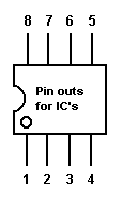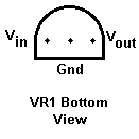
|
IMPROVED PL TONE ENCODER |
| BY N1HFX |
A significant amount of interest has been generated since my last article on a PL tone board. Because of this interest I decided to improve on the old PL tone design. Figure 1 is an inexpensive PL tone generator with significantly improved performance. It has a much more stable tone frequency as well as the elimination of the loading problem on the output. The transistor used in the old circuit would cause the tone frequency to change at high levels. This month's circuit eliminates all those problems.
Among the changes in this circuit are the use of a 78L05 IC voltage regulator instead of a resistor and a zener diode. This device looks like a transistor but has an extremely stable output voltage. The most important change is the use of an Op Amp as the output buffer. I originally tried using a Field Effect Transistor for buffering. Although it worked well, the FET did not have enough output. The 741 Op Amp reigns supreme once again.
The only rigid requirement is that capacitor C1 be stable over a wide temperature rate. Use only Mylar, Polyester or Metal film for capacitor C1. The tone frequency is determined by the following formula:
FREQUENCY = 1/R1C1
The specified values should allow any tone between 100 to 300 Hz. Increase R1 or add another resistor in series with R1 for lower tone frequencies.
The output of the PL tone generator should be connected to the deviation potentiometer in the transmitter circuit and not the microphone input. (Check schematic diagram of transceiver.) If the circuit reduces the transmitter audio, install a resistor between the output of the circuit and the transmitter. Use a value in the range of 1K to 1Meg (start with 100K) depending on what yields the best results.
To align the frequency of the tone generator, use another transceiver with CTCSS decode capability for the desired PL tone frequency. Attach a dummy load to the transmitter and key down the transmitter while turning R1. As soon as the correct frequency is obtained, the squelch will open on the transceiver with CTCSS decode. Now adjust R5 for the correct audio level of the tone. The tone level only needs to be load enough for the other receiver to decode the tone and not loud enough for others to hear. If the tone can be heard easily then the level is probably too high.
The LM567 IC and the 78L05 regulator are available from JDR MicroDevices (1-800-538-5000). All other parts are available at Radio Shack. The author will make a limited number of parts kits available for the usual low price of $5.
DE N1HFX
PARTS LIST
| IC1 | LM567 Tone Decoder/Encoder IC |
| IC2 | 741 Op Amp |
| VR1 | 78L05 5 volt low power regulator (DM105 Marking) |
| R1 | 10K 15 turn trimmer pot |
| R2 | 1K Resistor (Brown Black Red) |
| R3 | 10K Resistor (Brown Black Orange) |
| R4 | 100K Resistor (Brown Black Yellow) |
| R5 | 10K trimmer pot |
| C1 | 1 microfarad mylar, polyester, or metal film capacitor (105) |
| C2 | 10 microfarad electrolytic capacitor (observe polarity) |
| C3 | .01 microfarad capacitor (103) |
| C4,C5 | .1 microfarad capacitor (104) |

